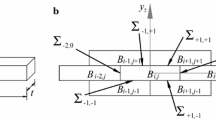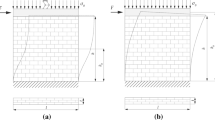Abstract
In this paper, a masonry system composed of a façade wall connected with two sidewalls and subjected to out-of-plane loading is investigated within the framework of three-dimensional limit analysis. Two different modeling approaches, namely macro and micro-block models, are adopted. A rigid-perfectly plastic model with dry contact interfaces governed by Coulomb failure criterion is assumed for masonry walls with regular units and staggering (non-standard limit analysis). Three classes of failure modes are investigated, involving rocking, sliding, twisting failure and combinations of them. The macro-block model is based on the assumption that the failure involves a number of cracks which separate the structure into a few macro-blocks and all the possible relative motions among micro-blocks are concentrated along the cracks. Two limiting conditions for the ultimate load factor are kinematically computed by use of minimization routines. The micro-block model is based on a concave contact formulation in which contact points are located at the corners of interfaces, allowing failure modes involving opening and sliding to be simulated. An iterative solution procedure is used to solve the non-associative friction problem, with second order cone programming (SOCP) used to allow the conic yield function to be solved directly. Both models are validated against experimental outcomes from the literature. A parametric analysis is carried out in order to highlight the influence of each geometrical and mechanical parameter on the prevalence of a mechanism over the other. The presence of an unrestrained horizontal floor system with different orientations is also analyzed.





















Similar content being viewed by others
References
Kooharian A (1952) Limit analysis of voussoir (segmental) and concrete arches. J Am Concr Inst 24(4):317–328
Heyman J (1966) The stone skeleton. Int J Solids Struct 2:249–279
Giuffrè A (1993) Safety and conservation of historical centres: the Ortigia Case (in Italian), Chap. 8. Guide to the seismic retrofit project. Editori Laterza, p 151–188
Orduña A (2003) Seismic assessment of ancient masonry structures by rigid blocks limit analysis. Ph.D. thesis, University of Minho, Guimarães (Portugal)
Lagomarsino S, Resemini S (2009) The assessment of damage limitation state in the seismic analysis of monumental buildings. Earthq Spectra 25(2):323–346
Ochsendorf J, Huerta S, Hernando JI (2004) Collapse of masonry buttresses. J Archit Eng ASCE 10(3):88–97
Roca P, Cervera M, Gariup G, Pela’ L (2010) Structural analysis of masonry historical constructions. Classical and advanced approaches. Arch Comput Methods Eng 17:299–325
Villaggio P (2011) Sixty years of solid mechanics. Meccanica 46(6):1171–1189
Livesley RK (1978) Limit analysis of structures formed from rigid blocks. Int J Num Method Eng 12:1853–1871
Delbecq JM (1982) Analyse de la stabilité des voûtes en maçonnerie par le calcul á la rupture. J. De Mécanique théorique et appliquée 1:91–121
Como M (1992) Equilibrium and collapse analysis of masonry bodies. Meccanica 27(3):185–194
Gilbert M, Melbourne C (1994) Rigid-block analysis of masonry structures. Struct Eng 72:356–361
Boothby TE (1994) Stability of masonry piers and arches including sliding. J Eng Mech 120:304–319
Sutcliffe DJ, Yu HS, Page AW (2001) Lower bound limit analysis of unreinforced masonry shear walls. Comput Struct 79:1295–1312
Portioli F, Casapulla C, Cascini L, D’Aniello M, Landolfo R (2013) Limit analysis by linear programming of 3D masonry structures with associative friction laws and torsion interaction effects. Arch Appl Mech 83(10):1415–1438
Begg DW, Fishwick RJ (1995) Numerical analysis of rigid block structures including sliding. Comput Meth Struct Mason 3:177–183
Baggio C, Trovalusci P (2000) Collapse behaviour of three-dimensional brick-block systems using non-linear programming. Struct Eng Mech 10(2):181–195
Ferris M, Tin-Loi F (2001) Limit analysis of frictional block assemblies as a mathematical program with complementarity constraints. Int J Mech Sci 43:209–224
Orduña A, Lourenço P (2003) Cap model for limit analysis and strengthening of masonry structures. J Struct Eng 129(10):1367–1375
Gilbert M, Ahmed HM, Casapulla C (2003) Computational limit analysis of masonry structures in the presence of non-associative friction. In: Proceedings of 6th international symposium STRUMAS VI, Rome, Italy, p 1–8
Gilbert M, Casapulla C, Ahmed HM (2006) Limit analysis of masonry block structures with non-associative frictional joints using linear programming. Comput Struct 84(13–14):873–887
De Lorenzis L, Dimitri R, Ochsendorf J (2012) Structural study of masonry buttresses: the trapezoidal form. ICE Proc Struct Build 165(9):483–498
De Lorenzis L, Dimitri R, Ochsendorf J (2012) Structural study of masonry buttresses: the stepped form. ICE Proc Struct Build 165(9):499–521
Drucker DC (1954) Coulomb friction, plasticity and limit loads. J Appl Mech 21(1):71–74
Restrepo-Vélez LF, Magenes G (2005) A mechanics based methodology for the evaluation of the seismic risk of unreinforced masonry buildings. Research Report No. ROSE-2005/05. IUSS Press, Pavia
Restrepo-Vélez LF, Magenes G, Griffith MC (2014) Dry stone masonry walls in bending—Part I: Static tests. Int J Archit Heritage 8(1):1–28
Casapulla C, Portioli F, Maione A, Landolfo R (2013) A macro-block model for in-plane loaded masonry walls with non-associative Coulomb friction. Meccanica 48(9):2107–2126
Portioli F, Cascini L, Casapulla C, D’Aniello M (2013) Limit analysis of masonry walls by rigid block modelling with cracking units and cohesive joints using linear programming. Eng Struct 57:232–247
Cei C (2009) Conservation and restoration of UNESCO sites and built heritage in the Sultanate of Oman. Practical activities and analytical models of the structural behaviour. Ph.D. thesis, University of Pisa, Italy
Sassu M, Andreini M, Casapulla C, De Falco A (2013) Archaeological consolidation of UNESCO masonry structures in Oman: the Sumhuram Citadel of Khor Rori and the Al-Balid Fortress. Int J Archit Heritage 7(4):339–374
Casapulla C (2001) Dry rigid block masonry: safe solutions in presence of Coulomb friction. Adv Archit Ser 7:251–261
Casapulla C, D’Ayala D (2006) In-plane collapse behaviour of masonry walls with frictional resistances and openings, vol. 2. In: Proceedings of 5th international conference SAHC06, New Delhi, India, p 1159–1166
Casapulla C (1999) Resistenze attritive in una parete muraria soggetta ad azioni normali al suo piano medio. In: Proceedings of 9th national conference Anidis, Torino, Italy, (CD-R, in Italian)
Orduña A, Lourenço PB (2005) Three-dimensional limit analysis of rigid blocks assemblages. Part I: torsion failure on frictional joints and limit analysis formulation. Int J Solids Struct 42(18–19):5140–5160
Casapulla C, Maione A (2011) Out-of-plane local mechanisms in masonry buildings. The role of the orientation of horizontal floor diaphragms. In: Proceedings of 9th Australasian masonry conference, Queenstown, New Zealand, p 225–235
Casapulla C (2008) Lower and upper bounds in closed form for out-of-plane strength of masonry structures with frictional resistances. In: Proceedings of 6th International Conference SAHC08, Bath, UK, vol. 2, p 1191–1198
Livesley RK (1992) A computational model for the limit analysis of three-dimensional masonry structures. Meccanica 27(3):161–172
Portioli F, Casapulla C, Gilbert M, Cascini L (2014) Limit analysis of 3D masonry block structures with non-associative frictional joints using cone programming. Comput Struct (under review)
(2011) The MOSEK optimization tools manual. MOSEK ApS, Denmark 2011
Acknowledgments
The authors acknowledge the sponsorship of the Italian Civil Protection, through the three-year RELUIS Project—Line 1-Task 1 (2010–2013).
Author information
Authors and Affiliations
Corresponding author
Rights and permissions
About this article
Cite this article
Casapulla, C., Cascini, L., Portioli, F. et al. 3D macro and micro-block models for limit analysis of out-of-plane loaded masonry walls with non-associative Coulomb friction. Meccanica 49, 1653–1678 (2014). https://doi.org/10.1007/s11012-014-9943-8
Received:
Accepted:
Published:
Issue Date:
DOI: https://doi.org/10.1007/s11012-014-9943-8




